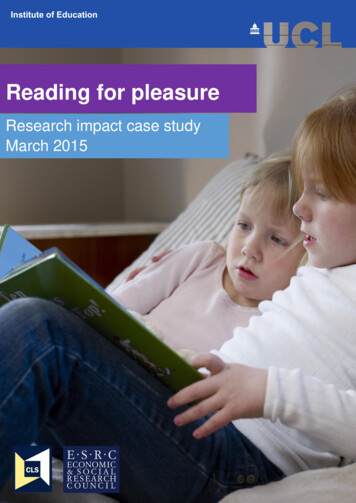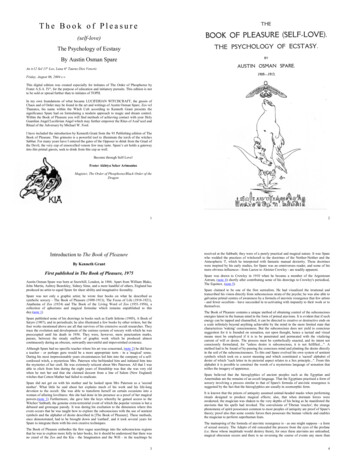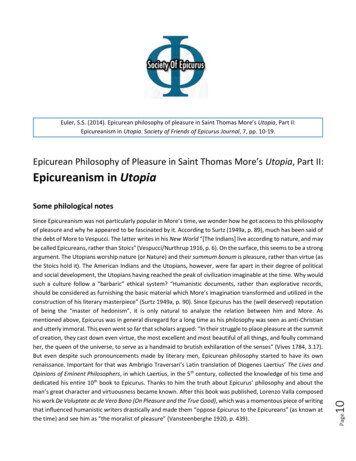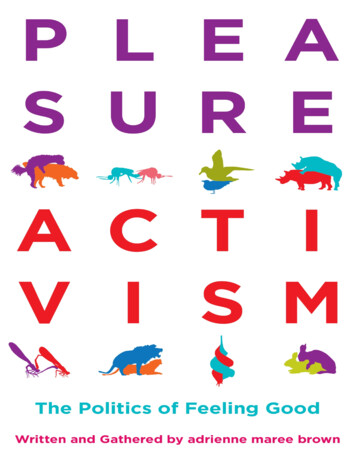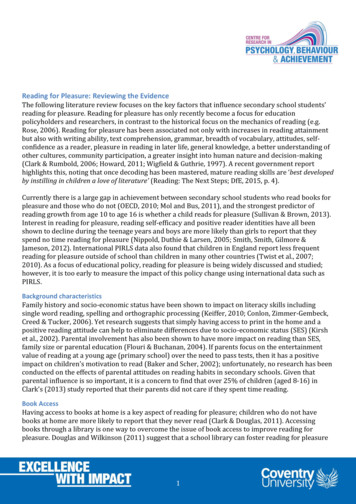
Transcription
Reading for Pleasure: Reviewing the EvidenceThe following literature review focuses on the key factors that influence secondary school students’reading for pleasure. Reading for pleasure has only recently become a focus for educationpolicyholders and researchers, in contrast to the historical focus on the mechanics of reading (e.g.Rose, 2006). Reading for pleasure has been associated not only with increases in reading attainmentbut also with writing ability, text comprehension, grammar, breadth of vocabulary, attitudes, selfconfidence as a reader, pleasure in reading in later life, general knowledge, a better understanding ofother cultures, community participation, a greater insight into human nature and decision-making(Clark & Rumbold, 2006; Howard, 2011; Wigfield & Guthrie, 1997). A recent government reporthighlights this, noting that once decoding has been mastered, mature reading skills are ‘best developedby instilling in children a love of literature’ (Reading: The Next Steps; DfE, 2015, p. 4).Currently there is a large gap in achievement between secondary school students who read books forpleasure and those who do not (OECD, 2010; Mol and Bus, 2011), and the strongest predictor ofreading growth from age 10 to age 16 is whether a child reads for pleasure (Sullivan & Brown, 2013).Interest in reading for pleasure, reading self-efficacy and positive reader identities have all beenshown to decline during the teenage years and boys are more likely than girls to report that theyspend no time reading for pleasure (Nippold, Duthie & Larsen, 2005; Smith, Smith, Gilmore &Jameson, 2012). International PIRLS data also found that children in England report less frequentreading for pleasure outside of school than children in many other countries (Twist et al., 2007;2010). As a focus of educational policy, reading for pleasure is being widely discussed and studied;however, it is too early to measure the impact of this policy change using international data such asPIRLS.Background characteristicsFamily history and socio-economic status have been shown to impact on literacy skills includingsingle word reading, spelling and orthographic processing (Keiffer, 2010; Conlon, Zimmer-Gembeck,Creed & Tucker, 2006). Yet research suggests that simply having access to print in the home and apositive reading attitude can help to eliminate differences due to socio-economic status (SES) (Kirshet al., 2002). Parental involvement has also been shown to have more impact on reading than SES,family size or parental education (Flouri & Buchanan, 2004). If parents focus on the entertainmentvalue of reading at a young age (primary school) over the need to pass tests, then it has a positiveimpact on children’s motivation to read (Baker and Scher, 2002); unfortunately, no research has beenconducted on the effects of parental attitudes on reading habits in secondary schools. Given thatparental influence is so important, it is a concern to find that over 25% of children (aged 8-16) inClark’s (2013) study reported that their parents did not care if they spent time reading.Book AccessHaving access to books at home is a key aspect of reading for pleasure; children who do not havebooks at home are more likely to report that they never read (Clark & Douglas, 2011). Accessingbooks through a library is one way to overcome the issue of book access to improve reading forpleasure. Douglas and Wilkinson (2011) suggest that a school library can foster reading for pleasure1
by embedding it into the curriculum and ensuring that it is personalised to the student’s needs.Unfortunately, Clark (2010) found that 28% of students thought the library did not have anything thatwould interest them. There is evidence from the US that when college librarians have tried to makespaces more appealing to adolescents, they have trouble with other professionals not recognising theimportance of what they do: “I constantly have to defend my sci-fi and fantasy purchases to folk whothink students should be reading more intellectual material.” (Gilbert & Fisher, 2011; p. 484). Thishighlights an issue around materials being chosen based on teachers’ ideals rather than students’choice.Reading MaterialReading interest has been suggested to improve engagement and falls into two categories: individual(topic or personal interest) and situational interest (Clark & Phythian-Sence, 2008). Individualinterest is related to what a student personally finds interesting and is relatively stable, e.g. aninterest in sports fiction. Situational interest is short-lived and context dependent e.g. enjoyingfootball fiction only while the World Cup is on TV. Unfortunately, the research on these topics appearsto be conflicting due to differences in research methodology. Regardless of which type of interest ismost important, they both have the ability to create intrinsic motivation, which is vital for continuousengagement with reading (Gurthrie et al, 2006). Cognitive engagement with text occurs whenstudents show a willingness to overcome difficult reading tasks, by using self-regulation skills toguide their own reading. Guthrie, Wigfield & You (2012) proposed that both forms of engagement canbe encouraged within the classroom when the learning and knowledge goals provide ‘compellingcognitive reasons for learning the material’ (p.603), and that the learning is concerned with real-worldinteractions. In simpler terms, students are more engaged when they see the reading materials asrelevant to themselves. Yet texts within school tend not to be reflective of real life text, as they arefragmented, decontextualized passage extracts; they are not whole books, but rather only extractsgiven to students to be analysed (Burns and Myhill, 2004). This decreases the amount of time childrenhave to spend on the text and leads to less enjoyment of reading, in favour of textual analysis skills(Lockwood, 2008).Research has shown there are differences in what children choose to read in the home and what theyare required to read at school (Gregory and Williams, 2000), thus it is important to examine whateffect choice has on reading. When students were asked which book they had enjoyed most, 80% ofthem responded it was the one they had selected themselves (Gambrell et al., 1996). Casey (2010)found that students actively want more choice and to engage in discussions around texts that theyhave read. Research has also shown that children can read and comprehend more complex textswhen it is on a topic they enjoy; students who read a text above their reading age were more likely topersevere with the task if they perceived the topic to be enjoyable (Fulmer & Frijters, 2011; Wigfieldet al, 2008), possibly due to the fact that texts that are perceived as more interesting require lessprocessing demands on the individual (Daniel, Waddill, Finstad and Bourg (2000). Giving childrenchoice in their reading can also help them to become more aware of their own reader identities(Bang-Jenson, 2010). For these reasons, it is imperative that adolescents are given choice and controlover the materials they are reading. When children are given a choice in their book selection, they2
begin to develop a positive reader identity by taking more control over their reading habits. Driscoll(2013) reviewed class practices around the popular novel series “Harry Potter,” and found thatpopular texts such as this can still be used to teach contemporary literacy, as well as to promote socialinclusion and psychological development. Making reading relevant to adolescents and to real life(outside of classroom experience) is key (Gambrell, 2015).Being able to choose a book is an important skill; this has now been included in the KS3 curriculum‘pupils should be taught to: choose and read books independently for challenge, interest and enjoyment’.However, it is not known how many schools do teach their students how to select books. Historically,research suggests this is not explicitly taught in schools (Ross, 2006). Thus, if children are not taughthow to choose a book at home, they are unlikely to select a book for reading as they do not possessthe necessary skills. Moss and McDonald (2005) found that in classroom libraries, when teachers gavechildren space to choose their own books to read without monitoring them, it produced readingnetworks and positive reader identities; this shows the positive impact that free choice has onreading development.Clark and Phythian-Sence’s (2008) review highlights that choice is important for empowering andengaging students; however, it can have negative effects if the choices are not presentedsystematically or in a way in which the students are able to make an informed decision. Strugglingreaders have been shown to read less for pleasure due to classroom influences such as lack ofengaging materials (Garbe, Gross, Holle, & Weinhold, 2006). Ross (2001) highlights several ways tohelp make informed meaningful choices; these include: looking for clues about the story on the cover,looking at specific elements of the book (e.g. genre), looking for cautionary clues (e.g. specificelements that the pupil does not like), thinking about the desired reading experience (e.g. does thepupil want to feel sad/happy, or read for information), thinking about recommendations (from peersor teachers) and thinking about readability (i.e. text difficulty). Teaching students how to select abook is important for encouraging reading engagement as this can help to create a reading culturewithin the classroom (Pachtman & Wilson, 2006).Reading identitiesReader identity has been specifically shown to become more negative when children move fromprimary to secondary education (Clark et al., 2008; Lenters, 2006). An identity is a combination of theway one views themselves in relation to environmental norms, their experiences within theenvironment, and how they perceive these experiences (Hall, 2012). Thus, a reader identity is shapedbased upon what norms the school presents as ‘good reading’ and the experiences of reading that anindividual has, along with their interpretations of them. Research into reader identities tends to focuson in-depth qualitative research, thus no longitudinal results are available. Moreover, existing studiesare mainly from outside the UK. Adolescent readers (in American high schools) have been found toonly identify as a ‘reader’ based on book reading; if they read outside of school in non-traditionalformats (e.g. comics), then they do not tend to see themselves as readers (Kolb, 2014; Hall, 2012).Thus, it is important that the school environment presents a broad model of reading and ensures thatchildren have positive experiences of reading.3
Associated with the development of a reader identity is self-concept. Self-concept relates to how thereader perceives their own abilities (Shavelson, Hubner, & Stanton, 1976). If secondary schoolstudents have positive attitudes about their ability, they tend to perform better (Aunola, Leskinen,Onatsu-Arvilommi, & Nurmi, 2002; Chapman & Tunmer, 1995; Chapman, Tunmer, & Prochnow,2000). Adolescents have specifically been shown to read less for pleasure when they think they are‘not good at reading’ (Hughes-Hassell & Rodge, 2007; p.27). Twist et al. (2012) also found that for UKchildren, greater confidence in reading was associated with higher achievement, supporting thesefindings.Reading MotivationAccording to Guthrie and Wigfield (2000), reading motivation can be defined as “the individual’spersonal goals, values, and beliefs with regard to the topics, processes, and outcomes of reading” (p.405). Motivation towards reading can be split into two separate components: intrinsic motivation,which relates to personal enjoyment of texts, and extrinsic motivation, which relates to reading forrewards or due to environmental demands, e.g. passing tests (Wigfield and Guthrie, 1997). Wigfieldand Guthrie (1997) reported that several aspects of intrinsic motivation predict reading motivation;these include importance (belief that reading is valuable), curiosity (desire to learn about a particulartopic of personal interest), involvement (enjoyment of reading) and preference for challenging text(satisfaction of mastering or assimilating complex ideas in text). Taboada et al. (2009) found thatwhen controlling for previous reading performance and background knowledge, students’ (aged 910) intrinsic motivation could still significantly predict their performance on comprehension readingassessments, which suggests that students who were driven more by intrinsic motivation did betterin reading tests. Conversely, Morgan and Fuchs (2007) argued that early experience of failures inreading motivates poor readers only to read when they have to, which in turn leads to poorer readingskills.Wigfield and Guthrie (1997) reported that several aspects of extrinsic motivation also form part ofreading motivation: reading for recognition (pleasure in receiving recognition for success), readingfor grades (desire to be favourably evaluated by the teacher) and competition (the desire tooutperform others in reading). Reading due to extrinsic motivation has been associated negativelywith reading performance in longitudinal studies (Becker, McElvany, and Kortenbruck, 2010). Thenegative association between extrinsic reading motivation and reading performance might arise dueto extrinsically motivated students focusing on social rewards rather than on the text (Wang &Guthrie, 2004). Less research has been conducted to investigate extrinsic types of motivation. Twist etal. (2012) found that UK students are less motivated to read compared to other English speakingcountries (e.g. Northern Ireland, Australia and Canada). Students with the highest readingperformance actually reported the lowest levels of reading motivation. The survey used in Twist etal.’s (2012) study, however, may have a methodological flaw. The questionnaire included a mixture ofintrinsic and extrinsic factors; if these had been separated, two different relationships may have beenseen (Deci & Ryan, 2000).4
Motivation levels can also be affected by emotions. If a student feels stressed, nervous or anxiouswhilst reading, they are less likely to engage with reading in order to avoid these emotions (Guthrie,Wigfield & You, 2012). Therefore, it is important to alleviate these negative emotions within theclassroom. In order to motivate children in the most effective manner, it has been suggested thatreading needs to be of high-interest whilst being moderately challenging, and be complemented withtasks which are also moderately challenging (Gambrell, 2015).In order for students to be interested in choosing books, it is important to ensure that their personalinterests are met, or to encourage pupils to be more interested in books. Schraw, Flowerday, andLehman (2001) used research evidence to put forward several suggestions for increasing interest (orintrinsic motivation) within the classroom. These included: providing students with meaningfulchoices (see previous paragraph for more detail), using well-organised texts (organised by themes, orstructured in a familiar way), pre-selecting vivid texts (i.e. rich imagery), using familiar texts (authors,themes), encouraging active learning (thinking about what they have learnt/would like to learn), andhighlight the relevance of reading (emotional engagement, gaining knowledge, enjoyment). It isimportant to note that interest and choice are highly related concepts; if students have the correctstrategies in place for knowing how to choose a book, it is highly likely that they will choose a bookthat is of interest to them.Role ModelsTeachers have been shown to have a big impact on children (Cremin et al 2009), and thus it isimperative that they model the behaviours they want to encourage. Unfortunately, many primaryteachers tend to rely not on current books but on books they remember from their childhood(Cremin, Bearne et al., 2008; Cremin, Mottram et al., 2008). It is likely that a similar phenomenon isoccurring within secondary schools. It has been suggested that teachers need to model reading inorder to create reciprocal reading relationships and to help children develop their own preferencesand reading identities (Cremin et al., 2014).Digital identitiesWithin modern society, the way in which teenagers’ access reading material has changed. They nowread via tablets, I-phones, Kindles, magazines and websites, as well as traditional print materials(Clark & Douglas, 2011; Maybin, 2007; McTavish, 2014). Due to the fact that most teenagers are usingand reading via digital technology (Lenhart, 2015), it is important to examine identities and attitudessurrounding new media reading. PISA reports that young people who are extensively engaged inonline reading activities are generally found to be more proficient readers than those who are notengaged in online reading (OECD, 2010). However, Kolb (2015) found that when non-traditional print(print via a screen) was brought into the classroom, both teachers and students alike still identifiedreading as something to do with books. Picton & Clark (2014) reported that when students fromprimary and secondary schools were given e-books to use over the course of several months (schoolswere free to use the e-books as they wanted, thus the timeframe was not consistent for all students),it could improve reading motivation. However, the effect could only be observed for boys, whilst girlsremained stable in their reading motivation. Out of those eligible for FSM, enjoyment of reading on adevice remained stable, but enjoyment of reading via traditional paper methods decreased. Despite5
this, those receiving FSM did improve on their attitudes to reading, with fewer reporting that theyfound reading difficult. This suggests that digital reading specifically helps boys in low socioeconomic groups to improve their perceptions of their reading ability, though this could be at the costof a reduced enjoyment of reading via traditional paper methods. Research into digital reading is anemerging field. Further research is needed to explore the relationship between digital reading andfactors relating to reading for pleasure in secondary school students before firm conclusions can bedrawn.SummaryTo summarise the key influences on reading for pleasure: Reader identities – schools need to foster positive reader identities Create environments where students feel comfortable to read Ensure students have choice over the text they are reading Ensure students know how to select a text they will want to read (i.e. a text they will find interesting,enjoyable or suitably challenging) Make sure that reading material is relevant to everyday lives Ensure that students have access to reading material, both at home and in school Avoid overuse of external motivators – try not to focus on exams/grades Encourage parents to emphasise the enjoyment gained from reading6
ReferencesAunola, K., Leskinen, E., Onatsu-Arvilommi, T. & Nurmi, J-E. (2002). Three methods for studyingdevelopmental change: A case of reading skills and self-concept. British Journal of EducationalPsychology, 72, 343 -364.Bang-Jenson, V. (2010). A Children’s Choice Program: Insights into Book Selection, SocialRelationships, and Reader Identity. Language Arts, 87(3), 169-176.Baker, L., & Scher, D. (2002). Beginning readers' motivation for reading in relation to parental beliefsand home reading experiences. Reading Psychology, 23(4), 239-269.Becker,M., McElvany, N., & Kortenbruck, M. (2010). Intrinsic and extrinsic reading motivation aspredictors of reading literacy: A longitudinal study. Journal of educational psychology, 102(4), 773785.Burnett, C., Wolstenholme, C., Stiell, B., & Stevens, A. (2014). Beyond Booked Up: Final Report.BookTrust: London.Burns and Myhill, (2004). Interactive or inactive? a consideration of the nature of interaction in wholeclass teaching. Cambridge Journal of Education, 34(1), 35-49.Casey, C., & Byford, J. (2010). A phenomenological study of high school students' perceptions ofliterature. Journal for the Liberal Arts and Sciences, 14(3), 48-57.Chapman, J. W., & Tunmer, W. E. (1995). Development of young children's reading self-concepts: Anexamination of emerging subcomponents and their relationship with reading achievement. Journal ofEducational Psychology, 87, 154-167Chapman, J. W., Tunmer, W. E., & Prochnow, J. E. (2000). Early reading-related skills and performance,reading self-concept, and the development of academic self-concept: A longitudinal study. Journal ofEducational Psychology, 92(4), 703-708.Clark, C., & Teravainen, A. (2015). Teachers and Literacy: Their perceptions, understanding,confidence and awareness. National Literacy Trust. London.Clark, C. (2013). Children's and Young People's Reading in 2012: Findings from the 2012 AnnualLiteracy Survey. National Literacy Trust. London.Clark, C. (2010). Linking School Libraries and Literacy: Young people’s reading habits and attitudes totheir school library, and an exploration of the relationship between school library use and schoolattainment. National Literacy Trust. London.Clark, C., & Douglas, J. (2011). Young People’s Reading and Writing: An in-depth study focusing onenjoyment, behaviour, attitudes and attainment. National Literacy Trust. London.Clark, C., Osborne, S., & Akerman, R. (2008) Young people’s self-perceptions as readers: Aninvestigation including family, peer and school influences. London: National Literacy Trust.Clark, C., & Phythian-Sence, C. (2008). Interesting choice: The (relative) importance of choice andinterest in reader engagement. National Literacy Trust: London.Clark, C., & Rumbold, K. (2006). Reading for Pleasure: A research overview. Retrieved from London:National Literacy TrustConlon, E., Zimmer-Gembeck, M., Creed, P., & Tucker, M. (2006). Family history, self-perceptions,attitudes and cognitive abilities are associated with early adolescent reading skills. Journal ofResearch in Reading, 29(1), 11-32.7
Cremin, T., Mottram, M., Collins, F., Powell, S., & Safford, K. (2009). Teachers as readers: buildingcommunities of readers. Literacy, 43(1), 11-19.Cremin, Teresa; Bearne, Eve; Mottram, Marilyn and Goodwin, Prue (2008). Primary teachers asreaders. English in Education, 42(1) pp. 8–23.Cremin, T. Mottram, M. Bearne, E. &Goodwin, P. (2008). Exploring teachers' knowledge of children'sliterature. Cambridge Journal of Education, 38(4), 449–464.Department for Education. (2015). Reading: the next steps. LondonDouglas, J., & Wilkinson, S. (2011). School Libraries: A plan for improvement. National Literacy Trust.London.Driscoll, B. (2013). Using Harry Potter to teach literacy: different approaches. Cambridge Journal ofEducation, 43(2), 259-271.Flouri, E. & Buchanan, A. (2004) Early father’s and mother’s involvement and child’s later educationaloutcomes. British Journal of Educational Psychology, 74, 141-153.Fulmer, S. M., & Frijters, J. C. (2011). Motivation During an Excessively Challenging Reading Task: TheBuffering Role of Relative Topic Interest. The Journal of Experimental Education, 79(2), 185-208.Gambrell, L. B. (2015). Getting Students Hooked on the Reading Habit. Reading Teacher, 69(3), 259263.Gambrell, L. B., Palmer, B. M., Codling, R.M., & Mazzoni, S.A. (1996). Assessing motivation to read. TheReading Teacher, 49, 518–533.Garbe, C., Gross, M., Holle, K., & Weinhold, S. (2006). Teaching Adolescent Struggling Readers. AComparative Study of Good Practices in European Countries. Executive Summary.Gilbrt, & Fisher. (2011). Reading, Risk, and Reality: College Students and Reading for Pleasure. College& Research Libraries, 47.Gregory and Williams, (2000). City Literacies: Learning to read across generations and cultures.Routeledge: London 4-495.Guthrie, J.T., Wigfield, A., & You, W. (2012). Instructional contexts for engagement and achievement inreading. Handbook of Research on Student Engagement. 601-634Guthrie, J. T., Wigfield, A., Von Secker, C. (2000) Effects of integrated instruction on motivation andstrategy use in reading. Journal of Educational Psychology, 92(2), 331-341.Guthrie, J. T., Wigfield, A., Humenick, N. M., Perencevich, K. C., Taboada, A., & Barbosa, P. (2006).Influences of stimulating tasks on reading motivation and comprehension. Journal of EducationalResearch, 99, 232-245.Hall, L. A. (2012). Rewriting Identities: Creating Spaces for Students and Teachers to Challenge theNorms of What It Means to Be a Reader in School. Journal of Adolescent & Adult Literacy, 55(5), 368373.Hodges, G. (2010). Reasons for reading: why literature matters. Literacy, 44(2), 60-68.Howard, V. (2011). The importance of pleasure reading in the lives of young teens: Self-identification,self-construction and self-awareness. Journal of Librarianship and Information Science, 43(1), 46-55.Hugh Hope-Stone Associates. (2008). Booked up: Evaluation Report: Executive Summary. Booktrust.London.Hughes-Hassel, & Ridge. (2007). The leisure reading habits of urban adolescents. The Journal of Adult& Adolescent Literacy. 51(1), 22-83.8
Kieffer, M. J. (2010). Socioeconomic Status, English Proficiency, and Late-Emerging ReadingDifficulties. Educational Researcher, 39(6), 484-486.Kirsch, I., De Jong, J., Lafontaine, D., McQueen, J., Mendelovits, J., & Monseur, C. (2002). Reading forChange Performance and Engagement Across Countries Results from PISA 2000. Organisation forEconomic Co-operation and Development. Paris.Kolb, C. (2014). Relationships between Discourse, Reader Identity, and Reading Self-Efficacy in a HighSchool English Classroom: A Mixed Methods, Critical Ethnographic Study. (Unpublished doctoraldissertation). University of Minnesota,Lenhart, A. (2015). Teens, Social Media & Technology Overview 2015. Retrieved cial-media-technology-2015/Lenters, K. (2006). Resistance, struggle, and the adolescent reader. Journal of Adolescent & AdultLiteracy, 50(2), 136-146.Lockwood, M. (2008). Promoting reading for pleasure in the primary school. London: Sage.Maybin, J. (2013). What counts as reading? PIRLS, EastEnders and The Man on the Flying Trapeze.Literacy, 47(2), 59-66.McTavish, M. (2014). “I'll do it my own way!”: A young child's appropriation and recontextualizationof school literacy practices in out-of-school spaces. Journal of Early Childhood Literacy, 14(3), 319344Mol, S.E., & Bus, A.G. (2011). To read or not to read: A meta-analysis of print exposure from infancy toearly adulthood. Psychological Bulletin, 137(2), 267-296.Morgan, P. L., & Fuchs, D. (2007). Is there a bidirectional relationship between children's readingskills and reading motivation? Exceptional Children, 73(2), 165-183.Moss G and McDonald J W (2004) The borrowers: library records as unobtrusive measures ofchildren’s reading preferences. Journal of Research in Reading, 27 (4) 401-413.Nippold, M. A., Duthie, J. K., & Larsen, J. (2005). Literacy as a leisure activity: Free-time preferences ofolder children and young adolescents. Language, Speech, and Hearing Services in Schools, 36(2), 93102.OECD (2010). PISA 2009 Results: Learning to Learn – Student Engagement, Strategies and Practices(Volume III).Pachtman & Wilson, (2006). What do the Kids think? The Reading Teacher, 59(7), 680-684.Picton, I., & Clark, C. (2015). The Impact of Ebooks on the Reading Motivation and Reading Skills ofChildren and Young People: A study of schools using RM Books. National Literacy Trust. London.Rose, J. (2006). Independent review of the teaching of early reading. London, DfESRoss, C. S., (2006). Reading Matters: What the research reveals about reading, libraries andcommunity. Westport: Libraries Unlimited.Ruterana, P. C. (2012). The Making of a Reading Society: Developing a Culture of Reading in Rwanda.Linkoping, Linkoping University, 1(1), 63-6Shavelson, R., Hubner,J. & Stanton, G. (1976). Self-Concept: Validation of Construct Interpretations.Education & Educational Research. 46(3), 407-411.Smith, J. K., Smith, L. F., Gilmore, A., & Jameson, M. (2012). Students' self-perception of reading ability,enjoyment of reading and reading achievement. Learning and Individual Differences, 22(2), 202-206.9
SQW Consulting. (2010). I’ve looked at it at home every day: evaluation of Booktime book-gifting inEngland 2009/10. Booktrust, London.Sullivan, A., & Brown, M. (2013). Social inequalities in cognitive scores at age 16: The role of reading.CLS Working Paper 2013/10, Institute of Education.Taboada, A., Tonks, S., Wigfield, A., & Guthrie, J. T. (2009). Effects of motivational and cognitivevariables on reading comprehension. Reading & Writing Quarterly, 22, 85-106.Twist, L., Schagen, I., & Hodgson, C. (2007). Readers and Reading: the national report for England2006. NFER, Department for Education. UK.Twist, L., Sizmur, J., Bartlett, S., & Lynn, L. (2012). PIRLS 2011: Reading Achievement in England.NFER, Department for Education. UKWigfield, A., Guthrie, J. T., Perencevich, K. C., Taboada, A., Klauda, S. L., McRae, A., et al. (2008). The roleof reading engagement in mediating effects of reading comprehension instruction on readingoutcomes. Psychology in the Schools, 45, 432–445.Wigfield, A., & Guthrie, J. T. (1997). Relations of children’s motivation for reading to the amount andbreadth of their reading. Journal of Educational Psychology, 89, 420-432.Wang, J. H., & Guthrie, J. T. (2004). Modeling the effects of intrinsic motivation, extrinsic motivation,amount of reading, and past reading achievement on text comprehension between U.S. and Chinesestudents. Reading Research Quarterly, 39(2), 162-186.10
children, greater confidence in reading was associated with higher achievement, supporting these findings. Reading Motivation According to Guthrie and Wigfield (2000), reading motivation can be defined as "the individual's personal goals, values, and beliefs with regard to the topics, processes, and outcomes of reading" (p. 405).
